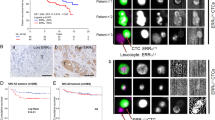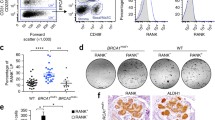Abstract
BRCA1 mutation carriers face a high lifetime risk of breast cancer, estimated at 60 % compared to 10 % in the general population. BRCA1 breast cancers typically have an aggressive course (i.e., high-grade, triple-negative) and are associated with a poor prognosis. At present, primary prevention is limited to prophylactic removal of the unaffected breasts. Effective chemopreventive strategies are not yet available. Emerging evidence suggests that BRCA1 mutation carriers have high circulating levels of progesterone which may play a role in their susceptibility to breast cancer. Recently, the RANK/RANKL system was found to be dysregulated in women with a BRCA1 mutation. Mutation carriers had significantly lower endogenous levels of osteoprotegerin (OPG) than women without a BRCA1 mutation. OPG is an endogenous decoy receptor for RANKL and inhibits RANKL-mediated signaling. RANKL binds to RANK on mammary epithelial cells and stimulates their proliferation and maturation. Low OPG levels may contribute to mammary tumorigenesis through increased proliferation and may explain in part the increased breast cancer risk in BRCA1 mutation carriers. Denosumab is an anti-RANKL monoclonal antibody which is approved to treat osteoporosis and to prevent skeletal damage caused by bone metastases. The emerging role of aberrant RANK-signaling in BRCA1 tumorigenesis suggests that targeting of RANKL may prevent breast cancer among women with germline BRCA1 mutations. Clinical investigations of denosumab are warranted and may lead to a novel chemopreventive approach for breast cancer for high-risk women.
Similar content being viewed by others
References
Chen S, Parmigiani G (2007) Meta-analysis of BRCA1 and BRCA2 penetrance. J Clin Oncol 25(11):1329–1333
Ford D et al (1994) Risks of cancer in BRCA1-mutation carriers. Lancet 343(8899):692–695
Antoniou A et al (2003) Average risks of breast and ovarian cancer associated with BRCA1 or BRCA2 mutations detected in case Series unselected for family history: a combined analysis of 22 studies. Am J Hum Genet 72(5):1117–1130
Da Silva L, Lakhani SR (2010) Pathology of hereditary breast cancer. Modern Pathol 23(Suppl 2):S46–S51
Mavaddat N et al (2012) Pathology of breast and ovarian cancers among BRCA1 and BRCA2 mutation carriers: results from the consortium of investigators of modifiers of BRCA1/2 (CIMBA). Cancer Epidemiol Biomark Prev 21(1):134–147
Chappuis PO, Nethercot V, Foulkes WD (2000) Clinico-pathological characteristics of BRCA1- and BRCA2-related breast cancer. Semin Surg Oncol 18(4):287–295
Foulkes WD et al (2004) Estrogen receptor status in BRCA1- and BRCA2-related breast cancer: the influence of age, grade, and histological type. Clin Cancer Res 10(6):2029–2034
Lakhani SR et al (1998) Multifactorial analysis of differences between sporadic breast cancers and cancers involving BRCA1 and BRCA2 mutations. J Natl Cancer Inst 90(15):1138–1145
Lakhani SR et al (2002) The pathology of familial breast cancer: predictive value of immunohistochemical markers estrogen receptor, progesterone receptor, HER-2, and p53 in patients with mutations in BRCA1 and BRCA2. J Clin Oncol 20(9):2310–2318
Robson ME (2002) Clinical considerations in the management of individuals at risk for hereditary breast and ovarian cancer. Cancer Control 9(6):457–465
Thompson D, Easton DF (2002) Cancer incidence in BRCA1 mutation carriers. J Natl Cancer Inst 94(18):1358–1365
The Breast Cancer Linkage Consortium (1999) Cancer risks in BRCA2 mutation carriers. J Natl Cancer Inst 91(15):1310–1316
Narod SA (2010) BRCA mutations in the management of breast cancer: the state of the art. Nat Rev Clin Oncol 7(12):702–707
Lubinski J et al (2012) The risk of breast cancer in women with a BRCA1 mutation from North America and Poland. Int J Cancer 131(1):229–234
Metcalfe K et al (2011) Risk of ipsilateral breast cancer in BRCA1 and BRCA2 mutation carriers. Breast Cancer Res Treat 127(1):287–296
Metcalfe K et al (2011) Predictors of contralateral breast cancer in BRCA1 and BRCA2 mutation carriers. Br J Cancer 104(9):1384–1392
Hartmann LC et al (1999) Efficacy of bilateral prophylactic mastectomy in women with a family history of breast cancer. N Engl J Med 340(2):77–84
Hartmann LC et al (2001) Efficacy of bilateral prophylactic mastectomy in BRCA1 and BRCA2 gene mutation carriers. J Natl Cancer Inst 93(21):1633–1637
Rebbeck TR et al (2004) Bilateral prophylactic mastectomy reduces breast cancer risk in BRCA1 and BRCA2 mutation carriers: the PROSE Study Group. J Clin Oncol 22(6):1055–1062
Rebbeck TR (2002) Prophylactic oophorectomy in BRCA1 and BRCA2 mutation carriers. Eur J Cancer 38(Suppl 6):S15–S17
Kauff ND et al (2008) Risk-reducing salpingo-oophorectomy for the prevention of BRCA1- and BRCA2-associated breast and gynecologic cancer: a multicenter, prospective study. J Clin Oncol 26(8):1331–1337
Finch A et al (2006) Salpingo-oophorectomy and the risk of ovarian, fallopian tube, and peritoneal cancers in women with a BRCA1 or BRCA2 mutation. JAMA 296(2):185–192
Finch AP et al (2014) Impact of oophorectomy on cancer incidence and mortality in women with a BRCA1 or BRCA2 mutation. J Clin Oncol 32(15):1547–1553
Kotsopoulos J et al (2017) Bilateral oophorectomy and breast cancer risk in BRCA1 and BRCA2 mutation carriers. J Natl Cancer Inst 109(1):djw177
Narod SA et al (2000) Tamoxifen and risk of contralateral breast cancer in BRCA1 and BRCA2 mutation carriers: a case–control study. Hereditary breast cancer clinical study group. Lancet 356(9245):1876–1881
Phillips KA et al (2013) Tamoxifen and risk of contralateral breast cancer for BRCA1 and BRCA2 mutation carriers. J Clin Oncol 31(25):3091–3099
Gronwald J et al (2014) Duration of tamoxifen use and the risk of contralateral breast cancer in BRCA1 and BRCA2 mutation carriers. Breast Cancer Res Treat 146(2):421–427
Metcalfe KA et al (2008) International variation in rates of uptake of preventive options in BRCA1 and BRCA2 mutation carriers. Int J Cancer 122(9):2017–2022
Metcalfe KA et al (2007) Variation in rates of uptake of preventive options by Canadian women carrying the BRCA1 or BRCA2 genetic mutation. Open Med 1(2):e92–e98
Metcalfe KA et al (2014) Health care provider recommendations for reducing cancer risks among women with a BRCA1 or BRCA2 mutation. Clin Genet 85(1):21–30
Ontario CC (2015) OBSP screening for women at high risk. https://www.cancercare.on.ca/cms/one.aspx?portalId=1377&pageId=99638.
Nagy V, Penninger JM (2015) The RANKL–RANK story. Gerontology 61(6):534–542
Hanley DA et al (2012) Denosumab: mechanism of action and clinical outcomes. Int J Clin Pract 66(12):1139–1146
Fata JE et al (2000) The osteoclast differentiation factor osteoprotegerin-ligand is essential for mammary gland development. Cell 103(1):41–50
Schramek D et al (2010) Osteoclast differentiation factor RANKL controls development of progestin-driven mammary cancer. Nature 468(7320):98–102
Gonzalez-Suarez E et al (2010) RANK ligand mediates progestin-induced mammary epithelial proliferation and carcinogenesis. Nature 468(7320):103–107
Asselin-Labat ML et al (2010) Control of mammary stem cell function by steroid hormone signalling. Nature 465(7299):798–802
Joshi PA et al (2010) Progesterone induces adult mammary stem cell expansion. Nature 465(7299):803–807
Poole AJ et al (2006) Prevention of BRCA1-mediated mammary tumorigenesis in mice by a progesterone antagonist. Science 314(5804):1467–1470
Joshi PA et al (2015) RANK signaling amplifies WNT-responsive mammary progenitors through R-SPONDIN1. Stem Cell Rep 5(1):31–44
Lim E et al (2009) Aberrant luminal progenitors as the candidate target population for basal tumor development in BRCA1 mutation carriers. Nat Med 15(8):907–913
Nolan E et al (2016) RANK ligand as a potential target for breast cancer prevention in BRCA1-mutation carriers. Nat Med 22(8):933–939
Sigl V et al (2016) RANKL/RANK control BRCA1 mutation-driven mammary tumors. Cell Res 26(7):761–774
Chlebowski RT et al (2013) Estrogen plus progestin and breast cancer incidence and mortality in the Women’s Health Initiative Observational Study. J Natl Cancer Inst 105(8):526–535
Anderson GL et al (2012) Conjugated equine oestrogen and breast cancer incidence and mortality in postmenopausal women with hysterectomy: extended follow-up of the Women’s Health Initiative randomised placebo-controlled trial. Lancet Oncol 13(5):476–486
Kotsopoulos J et al (2016) Hormone replacement therapy after menopause and risk of breast cancer in BRCA1 mutation carriers: a case–control study. Breast Cancer Res Treat 155(2):365–373
Widschwendter M et al (2015) Osteoprotegerin (OPG), the endogenous inhibitor of receptor activator of NF-kappaB ligand (RANKL), is dysregulated in BRCA mutation carriers. EBioMedicine 2(10):1331–1339
Vik A et al (2015) Serum osteoprotegerin and future risk of cancer and cancer-related mortality in the general population: the Tromso study. Eur J Epidemiol 30(3):219–230
Mavaddat N et al (2013) Cancer risks for BRCA1 and BRCA2 mutation carriers: results from prospective analysis of EMBRACE. J Natl Cancer Inst 105(11):812–822
Chlebowski RT et al (2015) Breast cancer after use of estrogen plus progestin and estrogen alone: analyses of data from 2 women’s health initiative randomized clinical trials. JAMA Oncol 1(3):296–305
Gnant M et al (2015) Adjuvant denosumab in breast cancer (ABCSG-18): a multicentre, randomised, double-blind, placebo-controlled trial. Lancet 386(9992):433–443
Gnant MPG, Dubsky PC, Hubalek M, Greil R, Jakesz R, Wette V, Balic M, Haslbauer F, Melbinger-Zeinitzer E, Bjelic-Radisic V, Artner-Matuschek S, Fitzal F, Marth C, Sevelda P, Mlineritsch B, Steger GG, Manfreda D, Exner R, Egle D, Bergh J, Kainberger F, Warner D, Fesl C, Singer CF, On behalf of the Austrian Breast and Colorectal Cancer Study Group (2016) The impact of adjuvant denosumab on disease-free survival: results from 3425 postmenopausal patients of the ABCSG-18 trial. Cancer Res 76(Supplement 4):S2–02
Sources of support
JK is the recipient of a Cancer Care Ontario Research Chair in Population Studies and a Canadian Cancer Society Career Development Award in Prevention. SAN is the recipient of a Canada Research Chair tier I.
Financial disclosures
The authors declare that there is no financial relationship with the organization that sponsored the research.
Author information
Authors and Affiliations
Corresponding author
Ethics declarations
Conflict of interest
The authors declare that there is no conflict of interest.
Rights and permissions
About this article
Cite this article
Kotsopoulos, J., Singer, C. & Narod, S.A. Can we prevent BRCA1-associated breast cancer by RANKL inhibition?. Breast Cancer Res Treat 161, 11–16 (2017). https://doi.org/10.1007/s10549-016-4029-z
Received:
Accepted:
Published:
Issue Date:
DOI: https://doi.org/10.1007/s10549-016-4029-z




